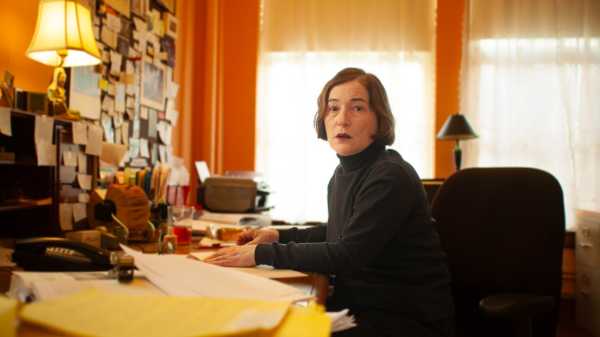
Save this storySave this storySave this storySave this story
Not long ago, I became a kind of undertaker. I was a fact checker at this magazine until recently and, in the final months of my tenure, it felt as if death was pouring in. I fielded the obituaries of some cherished colleagues—Roger Angell, Martin Baron, John Bennet, each one of them a braid in a rope pulling us back to the past. When they died, I got the copy. I called the families and the old acquaintances and asked this and that, trying, as best I could, to comfort them or make them laugh, while making sure that our facts were straight. Now another braid in the rope is gone: Joan Acocella.
Joan lived in a big, woody loft north of Union Square, in an old building where the elevator opened into the living room. When you arrived, Joan displayed the unyielding generosity of the Ghost of Christmas Present. She promptly asked you what you wanted to drink, unscrewed the bottle cap, and didn’t stop pouring. As well read and impressively educated as she was, she wore her learning lightly, a baseball cap tipped back so far it might tumble away in a strong wind.
By the time I got to The New Yorker, in 2011, Joan was an old hand. She bucked, sometimes roughly, when you told her she had got some little detail a little bit wrong, but her favorite phrase when dealing with people like me was “Good enough!” You’d keep talking and talking, proud you had chased out every angle of a questionable fact, and she’d interrupt you: “Good enough, Neima. Make the change.”
By that time, she knew the game. She had been an editor herself (at Dance Magazine) and had haggled with a lot of fact checkers over a lot of facts. She had become an expert at describing the gnomic, often unconscious, but precise twists and gestures of dancers—no easy feat! She did it for decades, at the Village Voice, The New York Review of Books, and, of course, The New Yorker. “Strong dancers are often correspondingly free,” she wrote in a review of a ballet at the Met. “They know that they can manage the next step, so they can afford to spend their time on what they have to say.”
Joan also had plenty to say about many subjects beyond dancing. I worked with her as she flipped through the Book of Job, did a jig on Gilgamesh, swung around Pinocchio, spun out the history of hoarding, and landed with ease on Chaucer’s Wife of Bath. One winter, Joan produced five thousand words on St. Francis of Assisi and spent a good deal of column inches describing his vow of poverty. Her own pledge, however, was to keep the reader awake. (“We’re in the entertainment business,” she sometimes told me.) St. Francis was serious about his vow, she explained, but not so serious as to be a giant bummer. “Francis believed in discipline—fasting, hair shirts—but he didn’t eat bugs,” she wrote. “He was fun, a quality not always found in saints.”
Joan was likewise a serious saint who prized fun. She once complained to me that she didn’t get to make as many jokes as she would have liked in her pieces—editors always holding her back!—but many good lines remained in the finished work. This is how her essay on hoarding starts: “My mother survived to the age of ninety-three, so she had time to develop a number of habits that people now consider to be symptomatic of dementia.” From a piece about Playboy centerfolds: “The breasts are smooth and round and pink; they look like balloons or beach balls. The girl seems delighted to have them, as if they had just been delivered by Santa Claus.” A snip from a review of Angela Carter’s feminist mythmaking: “Love is mixed with comedy. Three paragraphs later, it is mixed with death.”
Experienced critics have read a lot of books, and they occasionally rely on stuff that sticks in their memory from those books. Then people like me are charged with hunting down a half-remembered factoid, which the writer is sure they recall from somewhere (“I’m sorry, Neima, I can’t tell you where. But I know it’s true!”) Joan was incredibly shrewd. She had a Ph.D. in comparative literature and could tell a bad source from a good one, a good translation from one that was mostly ideological fluff, but there were just some details she had locked in her mind that were so perfect she couldn’t let them go.
Her piece on hoarders, for instance, mentioned the case of Homer and Langley Collyer, reclusive brothers who were found dead in 1947 amid heaps of junk that they had been accumulating for decades. In Joan’s draft, she had Homer dying in a chair with his face in his hands. Sadly, it was not so. He had died, yes, in a chair, but with his head in his lap, as if he had expired midthought. I knew what she was going for: overwhelmed by the old, reliable mounds that filled his home, he was now ashamed of the fact that he couldn’t let them go. This is how he died, as Joan recalled it; in a gesture of embarrassment.
I knew she wouldn’t be happy (it was better her way), so I prepared some words that might soothe her, and picked up the phone. “Joan, it gives me no pleasure to say this.” That was my line—no pleasure.
“Hmm,” she replied. “Let me look. Just a moment.” A pause. “What page did you say?” Another pause. “O.K. I see the sentence.” Pause again. “Look, I don’t quite believe it,” she said. “Neima, how old are you? You sound young. Are you thin?”
It was 2014. “I’m twenty-seven,” I said.
“Well, I’m old and fat. I’m trying to bend over and put my head on my knees and I can’t,” she explained. “Could you put the phone down and bend over and tell me whether you can reach your knees with your head?”
Sitting in my computer chair at the old offices in midtown, I bent at the waist like the dead Homer. With my temple resting on my knee I told Joan, “O.K., yes, I can do it.”
“Are you sure?” she said, “That was quick!”
“I haven’t put the phone down,” I told her. “I’m talking to you from my lap.”
She paused again and grunted softly. “O.K., Neima, good enough. You win. Make the fix.”
Over the phone was not always Joan’s favorite way to make changes. She was also, as all of her colleagues knew, a virtuoso of the fax machine. Technology progressed; Joan stayed true to faxing. Sometimes she would open an e-mail, begin a response in type, print the e-mail, take out a pen, complete the response in longhand under the printed e-mail, and then fax the whole thing back to you. It was as if the only way she could finish a thought was to hold it in her hands before she put it into the mouth of the machine and let the wires deliver it. On her typed drafts, she’d often scrawl her revisions in the margins in a script that few besides her editor, having attained the intimacy of a twin or a mother, could decipher.
Through time, Joan stayed the same. Or mostly so. As top-shelf writers age, their profound craft begins to slow them down. Like a strong dancer, you still see the steps, but you’re less flexible now, less correspondingly free. Joan knew this. In her final piece for the magazine, on the Wife of Bath and her many marriages, she provided an ending that spoke not only for the Wife but also for herself:
She has no regrets about her marital career so far:
Lord Christ! when I think back
Upon my youth, and on my gaiety,
It tickles me to the bottom of my heart. . . .
That I have had my day in my time.
But age, alas! that poisons everything,
Has robbed me of my beauty and my vigor;
Let it go, farewell, the devil go with it!
The flour is gone, there is no more to say,
The chaff, as best I can, I must sell now;
But still I will attempt to be right merry.
And off she goes, clomping down the road to Canterbury, on her fine horse.
By then, Joan was ready to clomp away, too. No regrets. But I am not ready to give her up. Is that a fax from Joan coming in? Soon I’ll be squinting at the words in the margins; soon I’ll know her well enough to decipher what they say. Joan is in her chair at her apartment north of Union Square scribbling her final thoughts at the bottom of an e-mail. Don’t tell me otherwise. No, I don’t want to hear your source. Can we leave it in? Just this once? Let me have it. O.K.? Good enough! ♦
Sourse: newyorker.com







